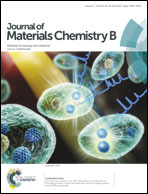Ti4+-immobilized multilayer polysaccharide coated magnetic nanoparticles for highly selective enrichment of phosphopeptides†
Abstract
Highly selective and efficient enrichment of trace phosphorylated proteins or peptides from complex biological samples is of profound significance for the discovery of disease biomarkers in biological systems. In this study, a novel immobilized metal affinity chromatography (IMAC) material has been synthesized to improve the enrichment specificity and sensitivity for phosphopeptides by introducing a titanium phosphate moiety on a multilayer polysaccharide (hyaluronate (HA) and chitosan (CS)) coated Fe3O4@SiO2 nanoparticle (denoted as Fe3O4@SiO2@(HA/CS)10–Ti4+ IMAC). The thicker multilayer polysaccharide endows excellent hydrophilic properties and a higher binding capacity of the titanium ion to the IMAC material. Due to the combination of uniform magnetic properties, highly hydrophilic properties and enhanced binding capacity of the titanium ion, the Fe3O4@SiO2@(HA/CS)10–Ti4+ nanoparticle possesses many merits, such as high selectivity for phosphopeptides (phosphopeptides/non-phosphopeptides at a molar ratio of 1 : 2000), extreme detection sensitivity (0.5 fmol), large binding capacity (100 mg g−1), high enrichment recovery (85.45%) and rapid magnetic separation (within 10 s). Moreover, the as-prepared IMAC nanoparticle provides effective enrichment of phosphopeptides from real samples (human serum and nonfat milk), showing great potential as a tool for the detection and identification of low-abundance phosphopeptides in biological samples.


 Please wait while we load your content...
Please wait while we load your content...